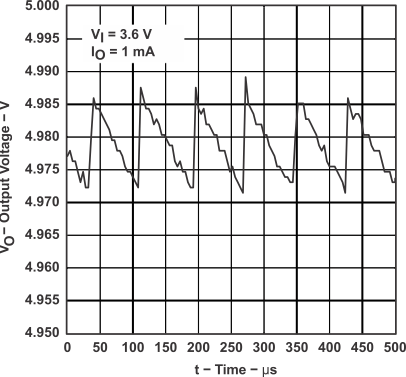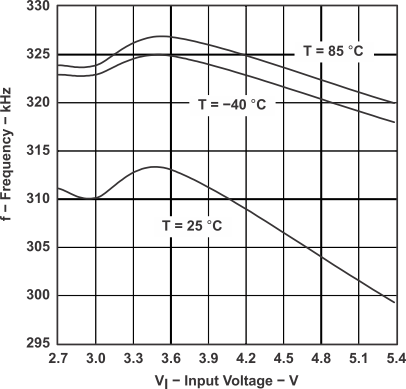SLVS258B November 1999 – December 2016 TPS60130 , TPS60131 , TPS60132 , TPS60133
PRODUCTION DATA.
- 1 Features
- 2 Applications
- 3 Description
- 4 Revision History
- 5 Device Options
- 6 Pin Configuration and Functions
- 7 Specifications
- 8 Parameter Measurement Information
- 9 Detailed Description
- 10Application and Implementation
- 11Power Supply Recommendations
- 12Layout
- 13Device and Documentation Support
- 14Mechanical, Packaging, and Orderable Information
Package Options
Mechanical Data (Package|Pins)
- PWP|20
Thermal pad, mechanical data (Package|Pins)
- PWP|20
Orderable Information
7 Specifications
7.1 Absolute Maximum Ratings
over operating free-air temperature range (unless otherwise noted)(1)| MIN | MAX | UNIT | ||
|---|---|---|---|---|
| Input voltage, VI (IN, OUT, ENABLE, FB, LBI, LBO/PG) | –0.3 | 5.5 | V | |
| Differential input voltage, VID | C1+, C2+ to GND | –0.3 | VO + 0.3 | V |
| C1−, C2− to GND | –0.3 | VI + 0.3 | ||
| Continuous total power dissipation | See Dissipation Ratings | |||
| Continuous output current | TPS60130 and TPS60131 | 400 | mA | |
| TPS60132 and TPS60133 | 200 | |||
| Maximum junction temperature | 150 | °C | ||
| Storage temperature, Tstg | 150 | °C | ||
(1) Stresses beyond those listed under Absolute Maximum Ratings may cause permanent damage to the device. These are stress ratings only, which do not imply functional operation of the device at these or any other conditions beyond those indicated under Recommended Operating Conditions. Exposure to absolute-maximum-rated conditions for extended periods may affect device reliability.
7.2 ESD Ratings
| VALUE | UNIT | |||
|---|---|---|---|---|
| V(ESD) | Electrostatic discharge | Human-body model (HBM), per ANSI/ESDA/JEDEC JS-001(1) | ±2000 | V |
| Charged-device model (CDM), per JEDEC specification JESD22-C101(2) | ±1000 | |||
| Machine model (MM) | ±200 | |||
(1) JEDEC document JEP155 states that 500-V HBM allows safe manufacturing with a standard ESD control process.
(2) JEDEC document JEP157 states that 250-V CDM allows safe manufacturing with a standard ESD control process.
7.3 Recommended Operating Conditions
over operating free-air temperature range (unless otherwise noted)| MIN | MAX | UNIT | |||
|---|---|---|---|---|---|
| VI | Input voltage | 2.7 | 5.4 | V | |
| IO | Output current | TPS60130 and TPS60131 | 300 | mA | |
| TPS60132 and TPS60133 | 150 | ||||
| TJ | Operating junction temperature | 125 | °C | ||
7.4 Thermal Information
| THERMAL METRIC(1) | TPS6013x | UNIT | |
|---|---|---|---|
| PWP (HTSSOP) | |||
| 20 PINS | |||
| RθJA | Junction-to-ambient thermal resistance | 178.75 | °C/W |
| RθJC(bot) | Junction-to-case (bottom) thermal resistance | 3.5 | °C/W |
(1) For more information about traditional and new thermal metrics, see the Semiconductor and IC Package Thermal Metrics application report.
7.5 Electrical Characteristics
over operating free-air temperature range (unless otherwise noted)| PARAMETER | TEST CONDITIONS | MIN | TYP | MAX | UNIT | ||
|---|---|---|---|---|---|---|---|
| VI | Input voltage | 2.7 | 5.4 | V | |||
| V(UVLO) | Input undervoltage lockout threshold | TC = 25°C | 1.6 | 1.8 | V | ||
| IO(MAX) | Maximum output current | TPS60130 and TPS60131 | 300 | mA | |||
| TPS60132 and TPS60133 | 150 | ||||||
| VO | 2.7 V < VI < 3 V, 0 < IO < IO(MAX)/2, TC = 0°C to 70°C |
4.8 | 5.2 | V | |||
| 3 V < VI < 5 V, 0 < IO < IO(MAX) | 4.8 | 5.2 | |||||
| 5 V < VI < 5.4 V, 0 < IO < IO(MAX) | 4.8 | 5.25 | |||||
| Ilkg(OUT) | Output leakage current | VI = 3.6 V, V(ENABLE) = 0 V | 1 | µA | |||
| IQ | Quiescent current (no-load input current) | VI = 3.6 V | 60 | 100 | µA | ||
| IQ(SDN) | Shutdown supply current | VI = 3.6 V, V(ENABLE) = 0 V | 0.05 | 1 | µA | ||
| fOSC(INT) | Internal switching frequency | 210 | 320 | 450 | kHz | ||
| VIL | Enable input voltage low | VI = 2.7 V | 0.3 × VI | V | |||
| VIH | Enable input voltage high | VI = 5.4 V | 0.7 × VI | V | |||
| Ilkg(ENABLE) | Enable input leakage current | V(ENABLE) = VGND or VI | 0.01 | 0.1 | µA | ||
| Output load regulation | VI = 3.8 V, 1 mA <IO(maximum), TC = 25°C |
0.002% | mA | ||||
| Output line regulation | 3 V < VI < 5 V, IO = 150 mA, TC = 25°C | 0.2% | V | ||||
| Short-circuit current limit | VI = 3.6 V, VO = 0 V, TC = 25°C | 115 | mA | ||||
| V(LBITRIP) | LBI trip voltage (TPS60130 and TPS60132) | VI = 2.7 V to 3.3 V, hysteresis 0.8% for rising LBI, TC = 0°C to 70°C | 1.15 | 1.21 | 1.27 | V | |
| II(LBI) | LBI input current (TPS60130 and TPS60132) | V(LBI) = 1.3 V | 100 | nA | |||
| VO(LBO) | LBO output voltage low (TPS60130 and TPS60132)(1) |
V(LBI) = 0 V, I(LBO)(SINK) = 1 mA | 0.4 | V | |||
| Ilkg(LBO) | LBO leakage current (TPS60130 and TPS60132) |
V(LBI) = 1.3 V, V(LBO) = 5 V | 0.01 | 0.1 | µA | ||
| V(PGTRIP) | Power Good trip voltage (TPS60131 and TPS60133) |
TC = 0°C to 70°C | 0.86 × VO | 0.9 × VO | 0.94 × VO | V | |
| Vhys(PG) | Power Good trip voltage hysteresis (TPS60131 and TPS60133) |
VO ramping negative, TC = 0°C to 70°C | 0.8% | ||||
| VO(PG) | Power Good output voltage low (TPS60131 and TPS60133)(1) |
VO = 0 V, I(PG)(SINK) = 1 mA | 0.4 | V | |||
| Ilkg(PG) | Power Good leakage current (TPS60131 andTPS60133) |
VO = 5 V, V(PG) = 5 V | 0.01 | 0.1 | µA | ||
(1) During start-up the LBO and PG output signal is invalid for the first 500 µs.
7.6 Dissipation Ratings
over operating free-air temperature (unless otherwise noted)| PACKAGE | TA ≤ 25°C POWER RATING | DERATING FACTOR ABOVE TA = 25°C |
TA = 70°C POWER RATING |
TA = 85°C POWER RATING |
|---|---|---|---|---|
| FREE-AIR TEMPERATURE (see Figure 21) | ||||
| PWP | 700 mW | 5.6 mW/°C | 448 mW | 364 mW |
| CASE TEMPERATURE (see Figure 22) | ||||
| PWP | 25 mW | 285.7 mW/°C | 22.9 mW | 18.5 mW |
7.7 Typical Characteristics
Table 3. Table of Graphs
| FIGURE | |||
|---|---|---|---|
| η | Efficiency | vs Output Current (TPS60130 and TPS60132) | Figure 1, Figure 2 |
| vs Input Voltage (TPS60130 and TPS60132) | Figure 3, Figure 4 | ||
| I | Supply Current | vs Input Voltage | Figure 5 |
| VO | Output Voltage | vs Output Current (TPS60130 and TPS60132) | Figure 6, Figure 7 |
| VO | Output Voltage Ripple | vs Input Voltage (TPS60130 and TPS60132) | Figure 8, Figure 9 |
| VO | Output Voltage Ripple Amplitude | vs Time | Figure 10, Figure 11, and Figure 12 |
| VPP | Output Voltage Ripple Amplitude | vs Input Voltage | Figure 13 |
| f(OSC) | Oscillator Frequency | vs Input Voltage | Figure 14 |
| Load Transient Response | Figure 15 | ||
| Line Transient Response | Figure 16 | ||
| VO | Output Voltage | vs Time (Start-Up Timing) | Figure 17 |







vs Input Voltage









